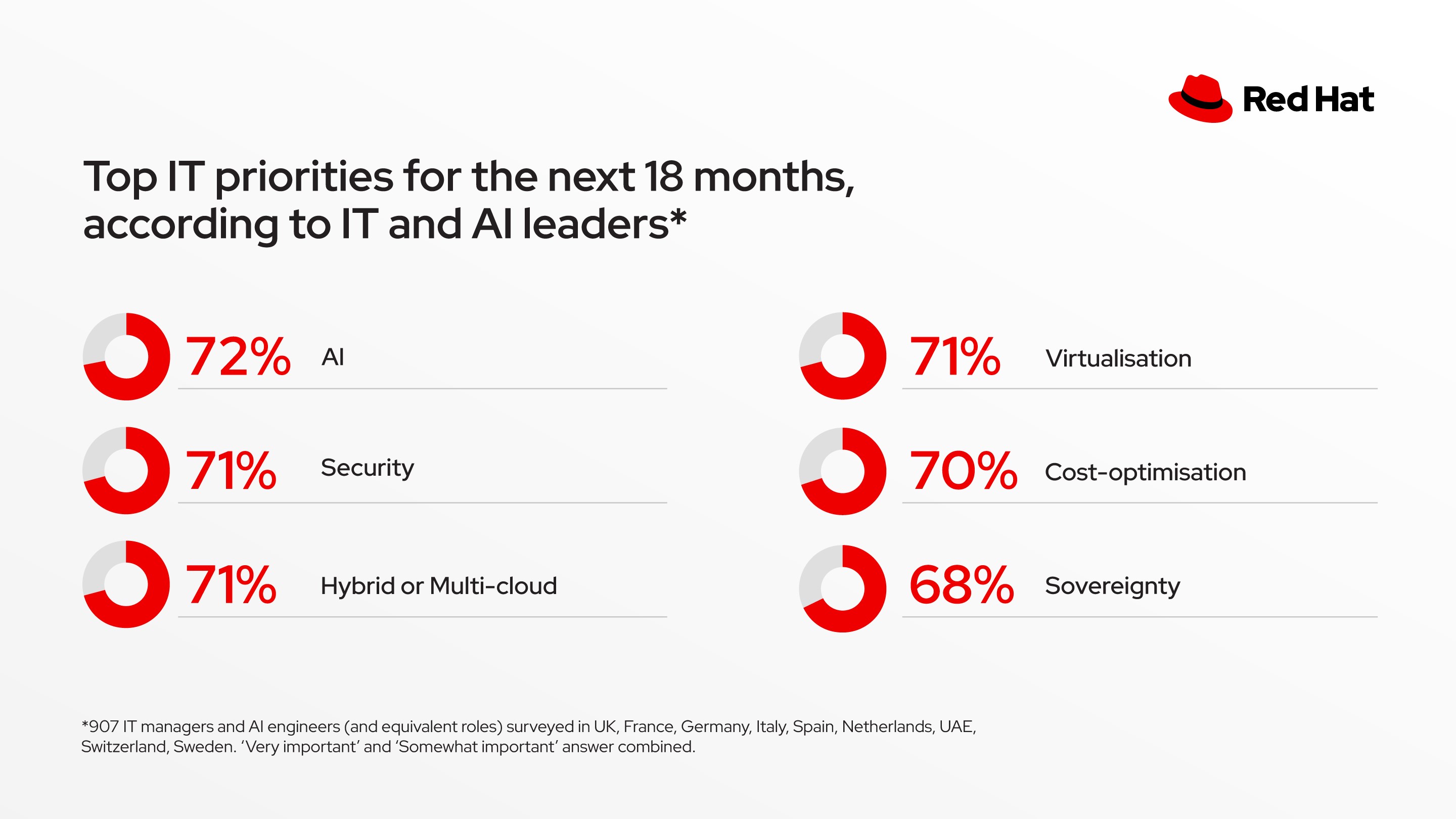Enterprise AI survey: ambition, the value gap, and the importance of open source
By Hans Roth, Senior Vice President & General Manager, EMEA, Red Hat

13 October, 2025 - Organisations are primed for widespread adoption of artificial intelligence (AI), and see enterprise open source as an important success factor; however, their ability to scale is challenged by skills gaps, high costs and shadow AI. That’s the headline finding of our latest survey of over 900 IT leaders and AI engineers in nine countries .
According to the survey, AI is a core strategic priority for 72% of organisations in Europe, the Middle East, and Africa (EMEA), and they have plans to increase their AI investments by an average of 32% by 2026 .
The focus on AI is clear, yet the data also reveals a stark gap between ambition and reality: only 7% of organisations report “driving customer value” at scale from their AI investments today . This is a crucial challenge for leaders who need to translate significant investment into tangible business outcomes.
So, what is preventing organisations moving from small-scale pilots to enterprise-wide value?
Tackling the barriers to scale AI
Our survey data outlines the extent of the talent shortage faced, with 70% of respondents agreeing there is an urgent AI skills gap3. The most significant gaps cited by those respondents are in the practical application of AI, such as connecting AI to enterprise data (49%), and making efficient use of AI capabilities (48%). Nearly as many (47%) report difficulty educating the business to use AI effectively, which complicates organisation-wide adoption.
As the role of AI in the workplace is established, another layer of complexity emerges. ‘Shadow AI’, the use of unsanctioned AI tools by employees, is becoming a significant challenge to effective governance and scalable adoption with a stronger security posture.
The vast majority of responding EMEA organisations (91% ) admit their organisation is experiencing a shadow AI problem. This should serve as a wake-up call: AI is being adopted with or without IT teams’ authorisation. This introduces new risks and underscores the need for internal education and guardrails, supported by platforms that are accessible, governed, and designed with users in mind.
The solution: a platform approach built on open source
Overcoming these barriers requires moving from a collection of fragmented tools to a unified platform strategy. IT leaders and AI developers in EMEA already recognise the path forward, as 92% agree that enterprise open source is important to their AI strategy . An enterprise open source AI platform can offer the consistency and control needed to build, deploy, and manage AI across any hardware and any cloud.
Organisations need a security-first, governed environment where teams can access the tools they need to experiment and build with confidence. Rather than spinning up lots of different systems in departmental silos (the top-rated barrier to AI adoption ), the use of an open source platform helps replicate success rather than reinvent the wheel. This approach allows IT to enable innovation, not block it, helping to fulfil a major AI priority for 75%2 of respondents: transparency and openness. Open source provides this transparency as well as increasing standardisation, helping enterprises retain control over AI and data decision-making. This control and flexibility is also vital to provide AI sovereignty, which is a priority for 74%2 of respondents.
An enterprise open source platform like Red Hat OpenShift AI also helps address the skills gap. By providing data scientists and developers with common tools and streamlined MLOps and LLMOps workflows, it boosts productivity as well as allowing organisations to tap into the broad range of talent and innovation within the open source ecosystem. It also simplifies connecting models to enterprise data to help solve the integration challenges that are top of mind7. Meanwhile Red Hat AI Inference Server optimises inference for faster, more cost-effective model deployments, which helps surmount the cost barrier cited by 29%7 of respondents.
By standardising on robust, open platforms, leaders can better control and govern AI, de-risk scale, and turn transparency into a competitive advantage.
From ambition to value
To close the AI value gap, organisations must match their ambition with an IT platform strategy that prioritises innovation, choice and scale – much as hybrid cloud platforms have borne out to be the most sustainable model for the cloud world. The path from pilot to production relies on the flexibility to adapt and the ability to scale when ready.
With a platform like Red Hat AI, EMEA enterprises have the foundation to do exactly that - scale, manage and secure AI on their own terms.
-ends-












